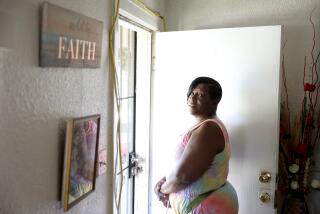County Centers Help Ease Trauma
- Share via
HAYWARD, Calif. — The curly-haired toddler wailed as he watched his 6-year-old brother walk away with a social worker one day last week, leaving him at a crisis center here with his sister.
A worker scooped up the boy, reassuring him that his brother would soon return. The older boy had gone to an emergency room for treatment of a gash on his arm and for an exam to determine any signs of physical abuse.
The toddler, a year old and still in diapers, had barely settled down after eating a few bites of jello and warmed-up ravioli when he was separated again, this time from his sister. He burst into tears once more as the girl, almost 3, left briefly with a child-care worker to take a shower.
The children had been taken away from their mother that morning after child protective services officials had been alerted to the possibility of abuse. Staff members at the Alameda County Children’s Assessment Center did their best to comfort the three.
Although the year-old center is not the first of its kind in the state, it reflects a trend that is increasingly catching on in California.
Under the concept, children removed from their homes remain in the centers for no more than a day while social workers assess their needs and try to find the best possible placements.
These centers are becoming a more popular alternative to shelters where children sometimes remain for weeks.
The trend to eliminate or modify shelters arose out of a San Francisco court decision more than two years ago that sided with an advocacy group, which had alleged that the shelters treated children poorly.
A San Francisco Superior Court judge ordered nine children’s shelters throughout the state to obtain licenses or close within 60 days. The ruling was made in response to a lawsuit against the state Department of Social Services by the Youth Law Center in San Francisco, which alleged the facilities were overcrowded and dangerous.
In Alameda County, children removed from their families because of neglect or abuse no longer wait in police stations or in the back seats of social workers’ cars until emergency foster homes become available. The county never had a children’s shelter.
“It wasn’t child-friendly,” said Lori Jones, program manager of Alameda County’s Assessment Center. “It was traumatizing to the child. They didn’t know what was going to happen next. We wanted to ease the trauma.”
In Contra Costa County, which opened the first of three centers six years ago, Linda Canan, child welfare manager, said she remembers children removed from their parents who sat on the floors of offices, listening as social workers discussed separating sisters and brothers to find foster homes.
To respond to some of these and other problems, the centers in Contra Costa and Alameda counties offer showers, food and other amenities in child-friendly settings.
Alameda County’s Assessment Center, which has seen 1,350 children in its first year of operation, also washes the youngsters’ clothing and gives them new outfits and shoes and even duffel bags, backpacks or suitcases. The children also get physical and mental health screenings, and a public health nurse follows up with future caretakers.
“We have been able to place siblings together,” Jones said. “We’ve had kids come in who had jobs. We’ve been able to link them to a home that lets them go to work.”
More to Read
Sign up for Essential California
The most important California stories and recommendations in your inbox every morning.
You may occasionally receive promotional content from the Los Angeles Times.













